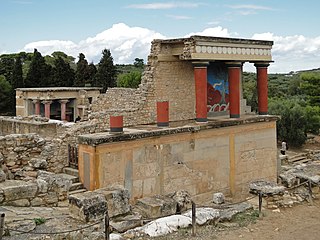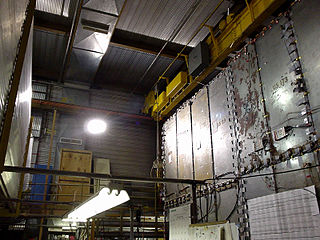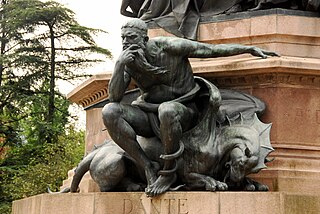Other
- Minos Prime, a boss from the 2020 video game Ultrakill
Minos was a mythical king of Crete.
Minos may also refer to:
IDE,iDE, or Ide may refer to:

In Greek mythology, the Minotaur is a mythical creature portrayed during classical antiquity with the head and tail of a bull and the body of a man or, as described by Roman poet Ovid, a being "part man and part bull". He dwelt at the center of the Labyrinth, which was an elaborate maze-like construction designed by the architect Daedalus and his son Icarus, on the command of King Minos of Crete. The Minotaur was eventually killed by the Athenian hero Theseus.

In Greek mythology, Minos was a King of Crete, son of Zeus and Europa. Every nine years, he made King Aegeus pick seven young boys and seven young girls to be sent to Daedalus's creation, the labyrinth, to be eaten by the Minotaur. After his death, King Minos became a judge of the dead in the underworld.

In ancient Greek religion and Greek mythology, Pasiphaë was a queen of Crete, and was often referred to as goddess of witchcraft and sorcery. The daughter of Helios and the Oceanid nymph Perse, Pasiphaë is notable as the mother of the Minotaur. She conceived the Minotaur after mating with the Cretan Bull while hidden within a hollow cow that the Athenian inventor Daedalus built for her, after Poseidon cursed her to fall in love with the bull, due to her husband, Minos, failing to sacrifice the bull to Poseidon as he had promised.

In Greek mythology, Rhadamanthus or Rhadamanthys was a wise king of Crete. As the son of Zeus and Europa he was considered a demigod. He later became one of the judges of the dead and an important figure in Greek mythology.
In Greek mythology, Polyidus, son of Coeranus, was a famous seer from Corinth.

Knossos is a Bronze Age archaeological site in Crete. The site was a major center of the Minoan civilization and is known for its association with the Greek myth of Theseus and the minotaur. It is located on the outskirts of Heraklion, and remains a popular tourist destination.

In Greek mythology, Talos — also spelled Talus or Talon — was a giant automaton made of bronze to protect Europa in Crete from pirates and invaders. He circled the island's shores three times daily.

In Greek mythology, Icarus was the son of the master craftsman Daedalus, the architect of the labyrinth of Crete. After Theseus, king of Athens and enemy of Minos, escaped from the labyrinth, King Minos suspected that Icarus and Daedalus had revealed the labyrinth's secrets and imprisoned them—either in a large tower overlooking the ocean or the labyrinth itself, depending upon the account. Icarus and Daedalus escaped using wings Daedalus constructed from feathers, threads from blankets, clothes, and beeswax. Daedalus warned Icarus first of complacency and then of hubris, instructing him to fly neither too low nor too high, lest the sea's dampness clog his wings or the sun's heat melt them. Icarus ignored Daedalus’s instructions not to fly too close to the sun, causing the beeswax in his wings to melt. Icarus fell from the sky, plunged into the sea, and drowned. The myth gave rise to the idiom, "fly too close to the sun."

In Greek mythology, the Cretan Bull was the bull Pasiphaë fell in love with, giving birth to the Minotaur.

Minoa was the name of several Bronze-Age port cities on the coasts of the Aegean islands Crete, Paros, Siphnos, Amorgos and Corfu in Greece, as well as the Italian island of Sicily. There was also a Minoa in Gaza, whose name was a later introduction, brought by the Philistines in 1200 BC. It appears that settlements with the name Minoa were intended to support Minoa as a thalassocracy, or sea-based empire. Austrian historian Fritz Schachermeyr found evidence for this in the name of a settlement on the Laconic island now called Monemvasia, and for the small island outside of the harbour of Megara in Greece.

Main injector neutrino oscillation search (MINOS) was a particle physics experiment designed to study the phenomena of neutrino oscillations, first discovered by a Super-Kamiokande (Super-K) experiment in 1998. Neutrinos produced by the NuMI beamline at Fermilab near Chicago are observed at two detectors, one very close to where the beam is produced, and another much larger detector 735 km away in northern Minnesota.

Soudan 2 was a particle detector located in the Soudan Mine in Northern Minnesota, United States, that operated from 1989 to 2001. It was a 960-ton iron tracking calorimeter whose primary purpose was to search for proton decay, although its data was also used to investigate the properties of neutrinos. It found no evidence of proton decay, but it did help confirm Super-Kamiokande's atmospheric neutrino result, supporting the theory of neutrino oscillation.

Minos is purported to be one of the dialogues of Plato. It features Socrates and a companion who together attempt to find a definition of "law".
In Greek mythology, Deucalion or Deukalion, was a king of Crete. He was counted among the Argonauts and the Calydonian Hunters.

In Greek mythology, the name Crete may refer to several figures, all of whom are associated with the homonymous island of Crete, and may have been considered its eponyms:
The Department of Physics at the Illinois Institute of Technology has over 30 faculty members. It offers undergraduate academic programs including B.S. in physics, applied physics, and physics education and graduate programs in physics and health physics. Many notable physicists have both taught and studied at IIT including Nobel Prize for Physics laureates Leon M. Lederman and Jack Steinberger.
MINOS+ was a continuation of the MINOS experiment to measure neutrino oscillation with improved electronics. It started taking data in 2013 and ran for 3 years. The experiment has ended and a 6-month dismantling project began in early October 2016.
MINOS is a Fortran software package for solving linear and nonlinear mathematical optimization problems. MINOS may be used for linear programming, quadratic programming, and more general objective functions and constraints, and for finding a feasible point for a set of linear or nonlinear equalities and inequalities.

Mayly Sánchez is a Venezuelan-born particle physicist who researches at Iowa State University. In 2011, she was awarded the Presidential Early Career Awards for Scientists and Engineers (PECASE), the highest honor given by the United States to scientists who are in the early stages of their research careers, for her contributions to the study of neutrinos and her work in promoting STEM fields to women. In 2013, she was named by the BBC as one of the top ten women scientists in Latin America.